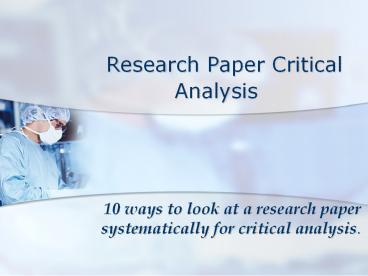Research Paper Critical Analysis PowerPoint PPT Presentation
Title: Research Paper Critical Analysis
1
Research Paper Critical Analysis
- 10 ways to look at a research paper
systematically for critical analysis.
2
NUR 599T Human Factors In Healthcare Engineering
- Dr. Vincent Duffy
- Research Paper Analysis
- Submitted by
- RuthAnn Smolen, RN, MS Ed, HNP,
- July 19, 2007
3
STUDY CRITIQUE Title Assessment of
Clinical Performance during Simulated Crises
Using Both Technical and Behavioral
RatingsAuthors Gaba, D., Howard, S.,
Flanagan B., Smith, B., Fish, K., Botney, R.
4
Research Ideas or Question(Study and Purpose)
- Study Assessment in clinical performance Gaba,
et.al.) - The purpose is clearly identified in the
introduction - - to evaluate ratings of performance (technical
and behavioral), and variability of ratings made
by multiple independent observers viewing
videotapes of simulated crises - The use of human patient simulators (HPS) in
health-care training is increasing to gain
knowledge, teach technical skills, complete drill
training, and human factors training for single
or multidisciplinary groups
5
2. Background
- Anesthesiology is recognized as the leading
medical specialty in addressing patient safety
with HPS - Pioneered development of computer screen and
mannequin based interactive patient simulators
and training plans (Schwid, 1987 Small, Wuetz,
Simon, Shapiro, Conn, Setnik, 1999). - A persistent initiative in graduate education is
to find more effective methods to assess
specialists skills - Techniques are needed to assess
anesthesiologists performance when responding to
critical events (Gaba, 1998) - Traditionally there has been concern about the
potential subjectivity of expert raters.
6
3. Theoretical Basis/Hypothesis
- Helmreich, RI Theory underlying CRM training
Psychological issues in flight crew performance
and crew coordination (NASA, 1986) in teams - Behavioral psychologists and learning theories
were used originally - In anesthesia, patient safety depends on a
complex interaction between a skilled
practitioner and technology - A human patient simulator may reduce the risk of
learning-curve error in anesthesiologists
technical and behavioral clinical performance
without subjecting patients to risk
7
4. Literature Search
- 13 reports published between 1980 2000 4 were
designed to investigate validity or reliability
of HPS systems overview of existing evidence of
the problem is addressed in follow-up searches of
today - In this study the literature review is supportive
of purpose and results, current for 1998, and
thorough - Summaries of other comparative studies are
discussed, relevant to the study and includes
strengths and weaknesses - Chopra, et al. (pg. 13)
- Devitt, et al. (pg. 13)
- Law and Sherman (pg. 15)
8
5. Applicability
- The aviation industrys commitment to simulation
and similarities between anesthesia and aviation
was a key rationale for developing courses in
crisis management and using simulation in
anesthesia education - Generalization among various acute events in
simulation teaching and evaluation environments
across healthcare disciplines is a reality today
9
6. Methodologies
- Raters scored the videotapes of 14 different
teams that were managing two scenarios malignant
hyperthermia (MH) and cardiac arrest. Technical
performance and crisis management behaviors were
rated.
10
7. Statistical Analyses Assumptions
- Using three observers, the study shows good
interrater reliability in scoring technical
achievement with less agreement between five
raters scoring ACRM behaviors. - The authors analyze the statistics of interrater
reliability in depth and note that the scoring
system requires further development before it can
be used for assess clinical competence for
residency/graduation, or board certification
11
8. Presentation of Results
- What do the results really mean?
- Team performance varied and correlations among
interraters were better for technical markers
than for behavioral markers
12
9. Conclusions (are they reasonable?)
- The rating system needs refinement before it can
be used to assess clinical competence for
residency/graduation, or board certification - This study suggests that simulation can be used
to measure more complex skills expected in
specialty training - Similar to other studies assessing complex
technical and behavioral performance multiple
encounters are needed to estimate skill
effectively and accurately
13
10. Future Work/Research Direction
- Studies emphasize the cognitive and social
aspects of designing and operating advanced
technologies yet to be developed - The behavioral rating system can be improved
difficulty aggregating a single rating that
fluctuated with time - Human Factors and ergonomics link quantitative
skills to the integrated systems and make sure
design of systems act in accordance with
requirement of users includes interactions with
technologists - Questions
- Is there a need for simulation in assessment of
clinical performance? - Do current simulators match the fidelity of a
real-live clinical setting? Are they realistic? - What are the potential uses of clinical
simulation in medical/healthcare education? - What role exists for simulation in healthcare
professional training and assessment? - Do collaborative opportunities exist?

